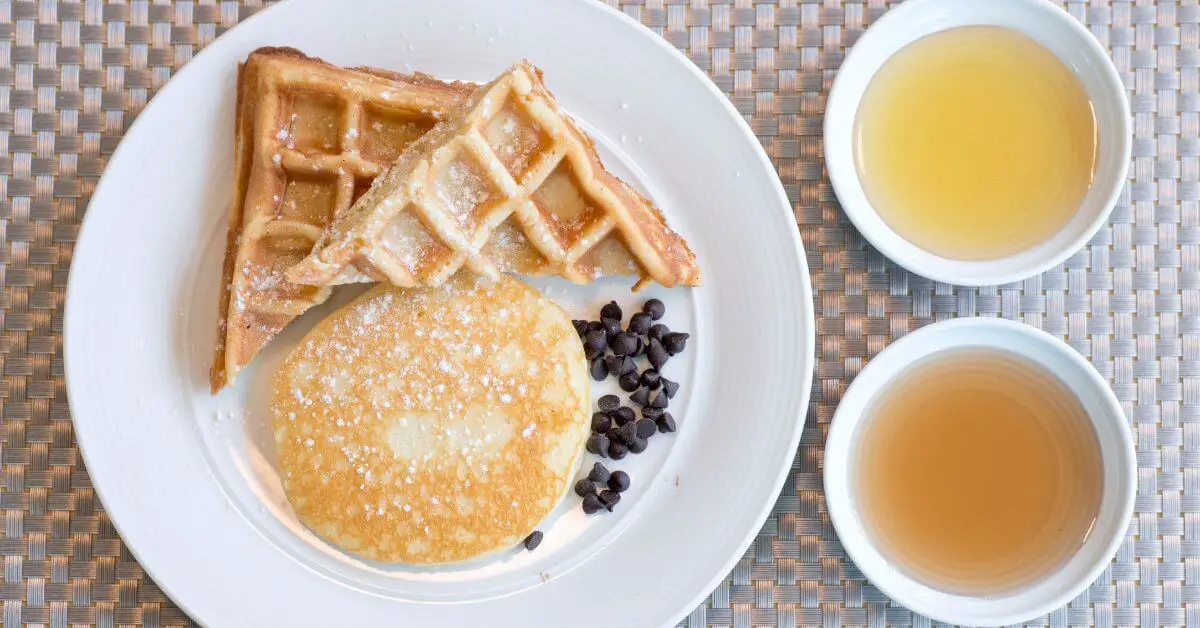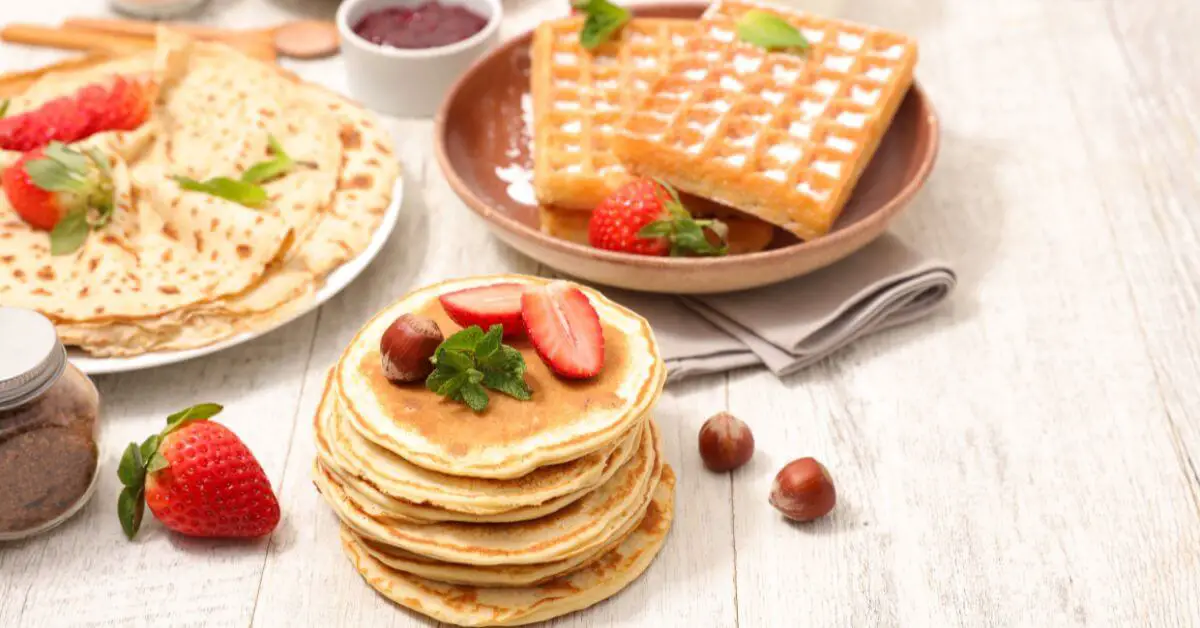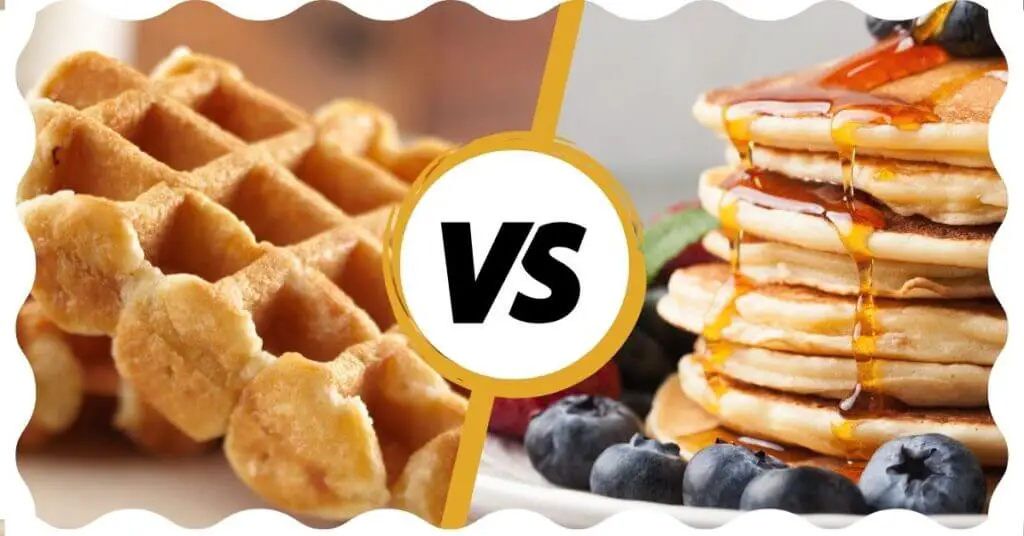In the classic breakfast debate of pancakes vs waffles, each holds its unique charm and fan base. This article explores their differences and similarities, from nutritional values to cultural significance. Pancakes, known for their fluffy texture, and waffles, with their distinctive crispy edges, both offer diverse culinary experiences. Whether you lean towards the soft embrace of a pancake or the crunchy delight of a waffle, this discussion aims to provide a comprehensive comparison, helping you decide which side of the breakfast table you stand on.
A. Nutritional Comparison
When comparing the nutritional aspects of pancakes and waffles, we focus on their caloric content, macronutrient profiles, and suitability for special diets.
-
Caloric Content:
- Pancakes generally contain fewer calories than waffles. Their batter typically requires less butter and sugar, reducing the overall calorie count.
- Waffles, with a richer batter that includes more butter and sugar, usually have higher calories. This is particularly true for Belgian waffles, which are larger and denser.
-
Macronutrient Profiles:
- Both pancakes and waffles primarily provide carbohydrates from flour. Waffles often contain more fat due to the additional butter or oil in their batter.
- The protein content in both pancakes and waffles can be similar, especially when made with milk and eggs. Adding ingredients like Greek yogurt or protein powder can increase the protein content.
-
Suitability for Special Diets:
- For gluten-free diets, both pancakes and waffles can use alternative flours like almond or rice flour.
- Vegan versions of pancakes and waffles use plant-based milk, flax eggs, and vegan butter or oil.
- Making pancakes and waffles healthier involves using whole grains, reducing sugar, and opting for healthy fats. Toppings like fresh fruits and natural sweeteners also enhance their nutritional value.
In summary, pancakes might have a slight edge in lower calorie content, but both pancakes and waffles can adapt to various dietary needs, making them versatile breakfast options.
B. Ease of Preparation

The ease of preparation for pancakes and waffles can significantly influence your choice, especially when considering the required equipment, preparation time, and skill level needed.
-
Required Equipment:
- Pancakes are relatively simple to make and require basic kitchen tools: a bowl for mixing, a whisk or spoon, and a frying pan or griddle. This accessibility makes pancakes a go-to option for many.
- Waffles, on the other hand, require a waffle iron. While waffle irons come in various styles and sizes, their necessity can be a limiting factor for those who don’t own one or have limited kitchen storage.
-
Preparation Time:
- Both pancakes and waffles have comparable batter preparation times, typically involving just mixing the ingredients. However, cooking time can vary.
- Pancakes cook relatively quickly, usually within minutes per side. They can be easily monitored and flipped on a stovetop.
- Waffles might take a bit longer, depending on the waffle iron. The preheating time for the iron and cooking time per waffle can add up, especially when making multiple servings.
-
Skill Level Needed:
- Making pancakes requires a basic skill level, with the primary challenge being flipping them at the right time to ensure even cooking.
- Waffles require less hands-on skill during the cooking process. Once the batter is poured into the iron, it does most of the work. However, getting the batter consistency right and knowing the optimal cooking time for your specific waffle iron can take some practice.
In summary, pancakes might edge out waffles in terms of ease of preparation, mainly due to the commonality of the required equipment and the simpler cooking process. However, both can be mastered with a little practice and are great options for a homemade breakfast.
C. Texture and Taste
The distinct textures and tastes of pancakes and waffles set them apart, offering unique sensory experiences.
-
Textures:
- Pancakes are famous for their soft, fluffy interiors and slightly crisp edges. They excel at absorbing syrups and toppings, providing a tender mouthfeel.
- Waffles boast a crispy exterior and light, airy inside. Their grid pattern creates pockets that hold toppings, adding crunch and flavor.
-
Flavor Profiles:
- Pancakes typically have a mild, buttery flavor, serving as a versatile base for various toppings and mix-ins. They easily adapt to flavors like buttermilk, blueberry, or chocolate chip.
- Waffles offer a richer taste due to their buttery and sweet batter. This gives them an indulgent flavor, even before adding toppings. Belgian waffles, in particular, are known for their dessert-like taste.
-
Recipe Variations:
- Pancakes come in many forms, including thin French crêpes, hearty oatmeal pancakes, and savory versions with herbs or cheese. International varieties like Russian blinis or Indian uttapams add to their diversity.
- Waffles also vary widely. Beyond classic Belgian waffles, there are whole grain and yeast-raised waffles, as well as savory options like potato waffles.
In essence, the choice between pancakes and waffles often boils down to personal texture and taste preferences. Whether you enjoy the softness of pancakes or the crispiness of waffles, both offer delightful breakfast experiences with vast customization possibilities.
D. Versatility and Variations
Pancakes and waffles are incredibly versatile, offering a wide range of types, flavors, and international variations that cater to both sweet and savory preferences.
-
Different Types of Pancakes and Waffles:
- Pancakes come in numerous types, from the classic American fluffy pancakes to thinner styles like French crêpes. There are also variations like oatmeal pancakes, buckwheat pancakes, and even protein-packed pancakes for a healthier twist.
- Waffles also boast a variety, including the well-known Belgian waffles, which are thicker and often larger than the standard American waffle. There are also Liege waffles, known for their richer, denser texture and sweet, pearl sugar bits.
-
Sweet and Savory Options:
- For sweet options, pancakes can be loaded with chocolate chips, topped with fruit compotes, or drizzled with maple syrup and whipped cream. Savory versions might include ingredients like herbs, cheese, or even bacon bits in the batter.
- Waffles can be served with sweet toppings like ice cream, chocolate sauce, or berries. Savory waffles might incorporate ingredients like cornmeal or cheese, and they pair exceptionally well with fried chicken, making the famous chicken and waffles dish.
-
International Variations:
- Pancakes have various international counterparts. In Russia, thin blinis are popular, often served with caviar or smoked salmon. In Japan, okonomiyaki presents a savory pancake loaded with cabbage and other ingredients. Ethiopia’s injera, a sourdough-risen flatbread, is another unique take on the pancake concept.
- Waffles, too, have international fame. Scandinavian countries have heart-shaped waffles, often served with jam and cream. In Hong Kong, egg waffles are a popular street food, known for their unique bubble-like appearance.
The versatility of pancakes and waffles is a testament to their global appeal and adaptability. Whether you’re in the mood for something classically sweet or daringly savory, or want to explore international flavors, there’s a pancake or waffle recipe out there to satisfy your cravings.
E. Toppings and Pairings

The realm of toppings and pairings for pancakes and waffles is vast and varied, offering endless possibilities for customization and creativity.
-
Popular Toppings for Each:
- Pancakes: Traditional toppings include maple syrup, butter, and fresh berries. For a sweeter treat, chocolate chips, whipped cream, or fruit compotes like apple or strawberry are popular choices. Nutella or peanut butter can add a rich, nutty flavor.
- Waffles: Classic waffle toppings also include syrup and butter, but due to their crispy texture, they hold up well to heavier toppings like ice cream or yogurt. Fruit toppings, such as banana slices or berry medleys, are also common, along with a dusting of powdered sugar or a drizzle of caramel.
-
Unique Pairing Ideas:
- Pancakes pair wonderfully with bacon or sausage for a classic savory contrast. For a healthier twist, pairing them with Greek yogurt and a sprinkle of granola adds texture and nutrition.
- Waffles can be turned into a decadent dessert by pairing them with chocolate sauce and strawberries, or for a savory meal, topped with fried chicken and a drizzle of honey.
-
Customization Options:
- Pancakes and waffles can be easily customized to suit dietary needs. Gluten-free flours, almond milk, or egg substitutes can be used to cater to specific dietary restrictions.
- Incorporating various spices into the batter, like cinnamon or pumpkin spice for pancakes and vanilla or almond extract for waffles, can add an extra flavor dimension.
Whether you prefer the classic combinations or are adventurous with your toppings and pairings, pancakes and waffles offer a delightful canvas to cater to your taste preferences.
F. Cultural and Regional Preferences
Pancakes and waffles hold different places in various cultures and regions:
- Regional Variations: In the U.S., pancakes are a staple in many households, often enjoyed with a side of bacon or eggs. Waffles, particularly Belgian waffles, are a favorite in many European countries and have gained popularity worldwide.
- Cultural Significance: Pancakes have cultural significance in events like Pancake Day or Fat Tuesday, marking the start of Lent. Waffles, meanwhile, are often associated with comfort food and are a popular choice in cafes and brunch spots.
- Popularity Trends: The popularity of pancakes and waffles can vary based on regional and cultural influences. In some areas, pancake houses are more prevalent, while in others, waffle houses dominate the breakfast scene.
Understanding the cultural and regional preferences can add an interesting dimension to the pancake versus waffle debate, highlighting how these breakfast items are more than just food; they’re a part of our cultural fabric.
G. Health and Dietary Considerations
Health and dietary considerations play a significant role in choosing between pancakes and waffles:
- Healthier Alternatives: Both pancakes and waffles can be made healthier by using whole grain flours, reducing sugar, or incorporating fruits and nuts. Gluten-free and vegan options are also available for those with dietary restrictions.
- Impact on Diet and Nutrition: While neither pancakes nor waffles are typically considered health foods, they can fit into a balanced diet when consumed in moderation. Pairing them with healthy toppings like fresh fruits or yogurt can enhance their nutritional value.
- Allergen Information: It’s important to consider allergens in pancake and waffle recipes, especially for those with sensitivities to gluten, dairy, or eggs. Fortunately, there are many alternative recipes available that cater to these dietary needs.
Incorporating pancakes or waffles into a healthy diet requires mindful preparation and topping choices. By opting for healthier versions and balancing them with nutritious sides, you can enjoy these breakfast favorites without compromising on health. For those considering health and dietary options, pancakes and waffles can be paired with lean proteins like chicken. Discover versatile ways to incorporate thin chicken breast recipes into your breakfast in our detailed guide.
FAQs
-
Which absorbs syrup better, pancakes or waffles?
- Pancakes excel in absorbing syrup evenly due to their fluffy texture, ideal for syrup lovers. Waffles, with their grid pattern, uniquely hold syrup in each pocket.
-
Do pancakes or waffles pair better with butter?
- Both pancakes and waffles complement butter well. Pancakes allow butter to melt evenly across the top, while waffles offer a delightful contrast with their crispy edges.
-
Which is more filling, pancakes or waffles?
- Pancakes generally are more filling, owing to their denser texture. Waffles, though lighter and crispier, might not satisfy hunger as much as pancakes.
-
Which is more versatile for adding ingredients, pancakes or waffles?
- Pancakes are more versatile for incorporating additional ingredients like fruits or chocolate chips. Waffles can also be customized, but added ingredients might affect their texture.
-
Is there a fun factor difference between pancakes and waffles?
- Waffles are often seen as more fun due to their unique shape and texture. Pancakes, while traditional, can also be enjoyable, especially when made into different shapes or with colorful toppings.
Conclusion
Pancakes and waffles each have unique appeals in the breakfast world. Pancakes win for versatility and ease, soaking up syrup beautifully. Waffles stand out with their crispy texture and fun eating experience. Whether you prefer pancakes or waffles, both bring joy and flavor to breakfast tables.
